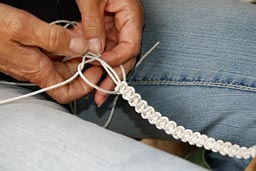Carpal Tunnel Syndrome
What is Carpal Tunnel Syndrome?
Carpal Tunnel Syndrome is a condition that arises when the median nerve gets compressed at the wrist. The Median Nerve is one of the three major nerves of the arm and hand – it supplies sensation to the thumb, index finger, middle finger and half of the ring finger. Less commonly it innervates the little finger too.
The Median Nerve also controls some of the movement of the thumb and fingers. This important nerve passes through the Carpal Tunnel, which is a napkin ring-like space covered by the Transverse Carpal Ligament. Within this space, along with the Median Nerve, are the flexor tendons that allow bending of the fingers. Carpal Tunnel Syndrome arises when these flexor tendons become thickened and occupy too much space in the Carpal Tunnel, leading to compression on the Median Nerve.
Symptoms of Carpal Tunnel Syndrome
Numbness and/or tingling in the thumb, index finger, middle finger, and possibly the ring and little fingers are the hallmarks of Carpal Tunnel Syndrome. Pain may also be present sometimes. In mild cases the numbness/tingling is intermittent, but as the Carpal Tunnel Syndrome becomes more severe the symptoms become constant. Severe Carpal Tunnel Syndrome also leads to weakness of the hand due to the loss of hand muscle strength, especially the thumb. Difficulty sleeping at night because of the discomfort also generally indicates a more advanced condition.
Common Causes of Carpal Tunnel Syndrome
Despite popular belief, repetitive motions like typing do not cause Carpal Tunnel Syndrome according to reliable research studies on this topic. Developing Carpal Tunnel Syndrome is largely due to a genetic predisposition, which becomes symptomatic at any time from adolescence to old age, but is most common in perimenopausal or pregnant women. Men also suffer from Carpal Tunnel Syndrome. Certain medical conditions, specifically Diabetes and Hypothyroidism, are known to be associated with developing Carpal Tunnel Syndrome.
Diagnosing Carpal Tunnel Syndrome
Speaking with you to understand the types of symptoms you experience and when is of the utmost important. A careful physical exam to evaluate the Median Nerve and other nerves of the arm and hand is also essential. An x-ray can help evaluate for possible abnormalities of the wrist joint that can contribute to the problem. A Nerve Conduction Study may be obtained to confirm the diagnosis of Carpal Tunnel Syndrome and helps to assess the severity.
Treatment Options for Carpal Tunnel Syndrome
Mild cases can be treated with splinting, occupational therapy, anti-inflammatory medication, and steroid injections. Some mild cases may resolve, others remain stable and persist, while many progress to more advanced Median Nerve compression. Severe or unresponsive cases of Carpal Tunnel Syndrome may benefit from surgery. The goal of surgery is to open the Carpal Tunnel so the Median Nerve has more room and is no longer compressed. In these cases, surgery can prevent the worsening of the condition and allows for recovery of the Median Nerve. The procedure may be performed endoscopically or open.
Endoscopic Carpal Tunnel Release involves one or two small incisions away from the base of the hand and results generally in a quicker and less painful recovery compared to open surgery. Grip and pinch strength is generally greater, as well, since this minimally invasive treatment results in less alteration of the musculature of the hand.
Conclusion
Carpal Tunnel Syndrome is a very common condition, but it can have serious consequence for the health of your hand. Call Dr. Pruzansky at 212-249-8700 to schedule an appointment and keep you hand feeling well.




